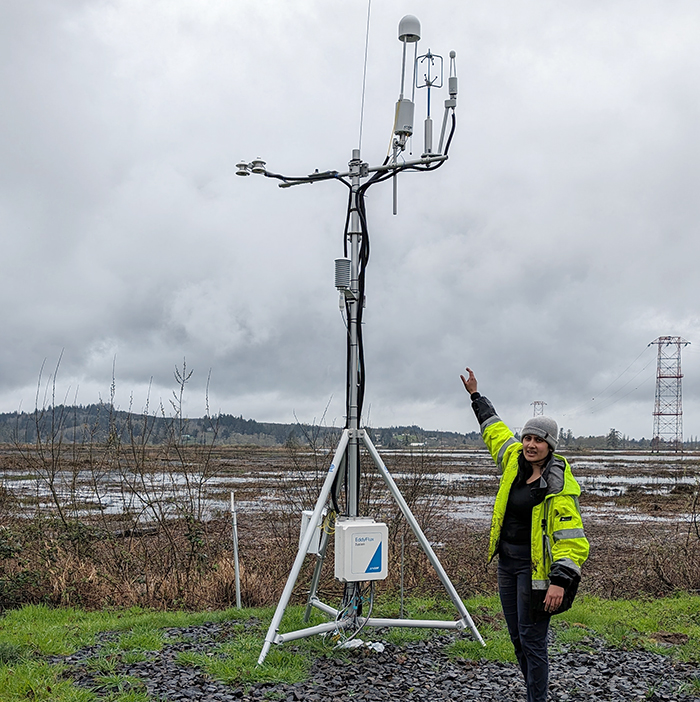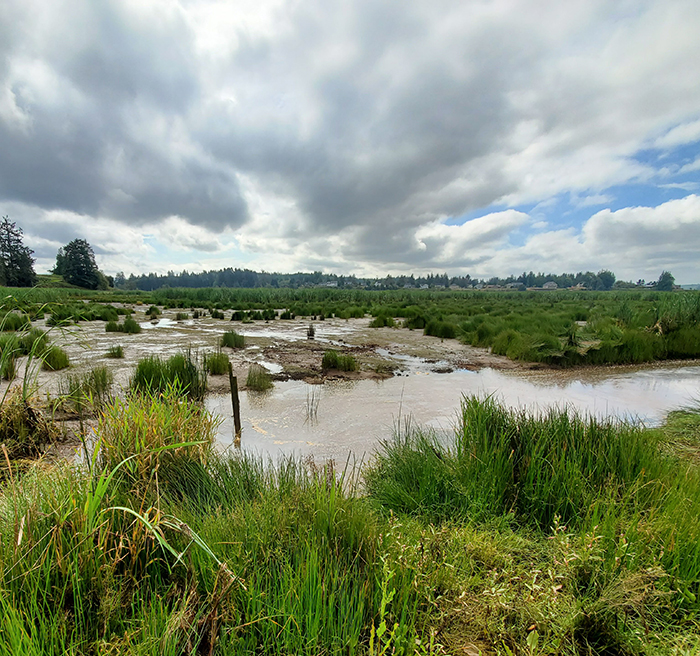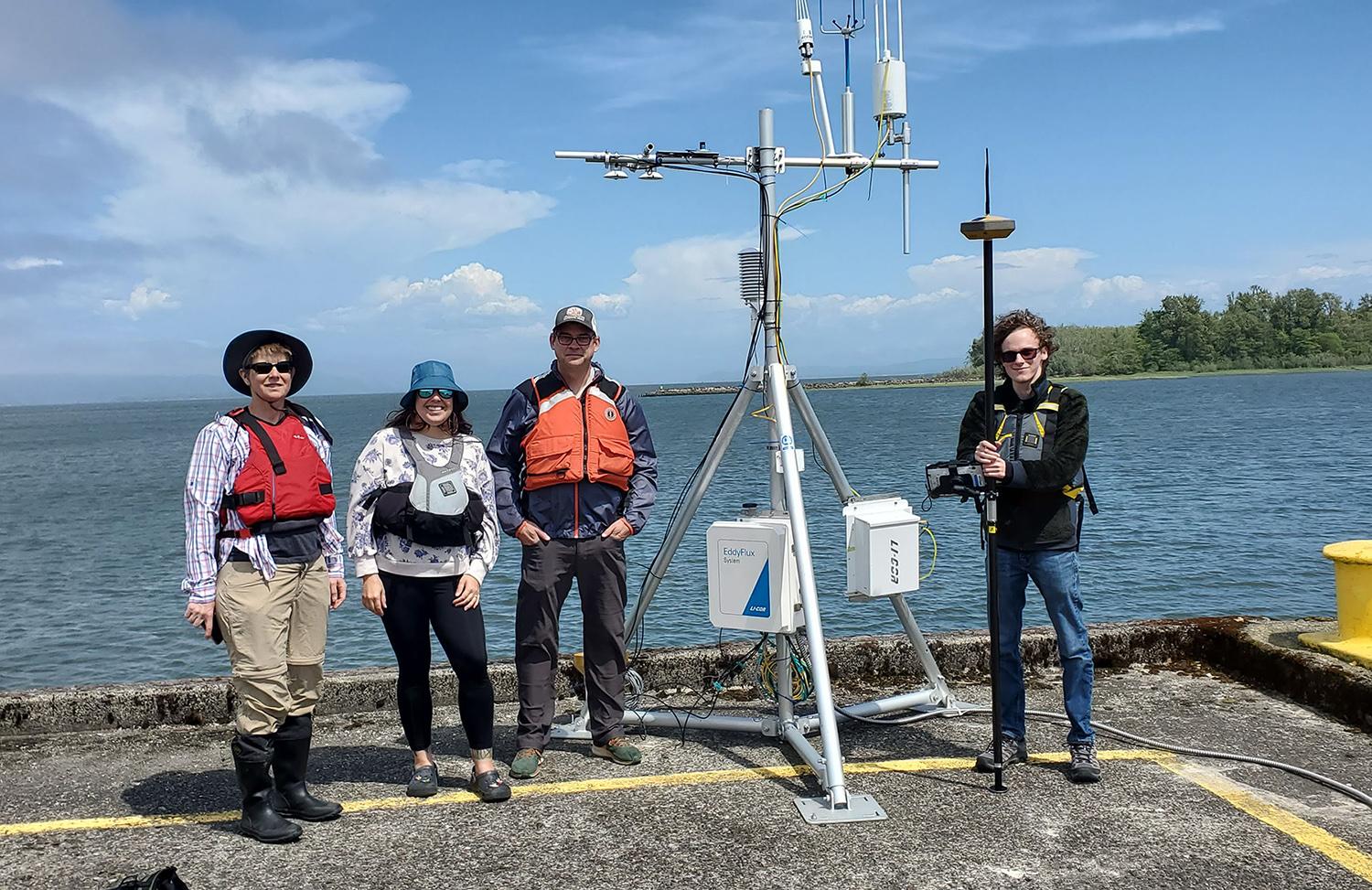Pioneering Study to Explore Carbon Methane Flux in Columbia River Estuary Wetlands
A new study is underway examining the role of Columbia River estuary wetlands in global efforts to reduce greenhouse gas emissions. In partnership with Oregon Health & Science University, and Portland State University, the Lower Columbia Estuary Partnership ’s Soil Carbon and Methane Study of Columbia River Estuary Wetlands evaluates the dual role of estuary wetlands in both storing and emitting gases including carbon dioxide and methane.

Tower at Wallooskee - Youngs wetland.
The Soil Carbon and Methane Study of Columbia River Estuary Wetlands project will examine the intricacies of carbon sequestration and methane emissions in wetlands in the Columbia River estuary. Data collected from this study will be used to inform modeling efforts, to quantify methane emissions and carbon sequestration, and to provide predictive capabilities for carbon storage and methane release across the entire Columbia River estuary.
Wetlands play an important role in the Earth’s carbon cycle – both capturing and storing carbon dioxide and emitting methane gas. Understanding the relationship between carbon capture and storage and methane release offers critical insight for policymakers and conservationists into how estuary wetlands can be managed to maximize efforts to combat climate change.
The project kicked off in 2023 with the installation of two Eddy Covariance Flux Towers. These towers, made in the U.S. by LI-COR and akin to sophisticated weather stations, measure local fluctuations in atmospheric gases that reflect sequestration or emission by physical and biological processes in the landscape.
One tower is on a fixed pier above the Columbia River near Astoria hosted by the Columbia River Intertribal Fish Commission (CRITFC) (location pictured below). The other tower is located at a restored wetland site owned by the Cowlitz Indian Tribe located in Youngs Bay (pictured above). In addition to hosting the eddy flux towers, CRITFC and the Cowlitz Indian Tribe are assisting with the monitoring and maintenance of research equipment.

To develop a predictive, estuary-wide model of Columbia River wetlands’ greenhouse gas exchange impacts, researchers must evaluate additional criteria. To accomplish this task, project researchers are comprehensively evaluating how environmental factors such as salinity, soil conditions, hydrology, and plant community composition interact with and influence greenhouse gas dynamics within wetland ecosystems. To assist in this data collection, researchers will rely on Uncrewed Aerial Vehicles (UAVs) and machine learning algorithms to help identify and map key features of the landscape.
The deeper understanding of greenhouse gas dynamics in the estuary developed through this project will be invaluable to future efforts to restore wetlands and manage wetlands habitat. With this work, policymakers and conservationists will have a clear and practical way to align Columbia River estuary wetlands management and conservation into the global conversation about greenhouse gases and mitigation.

Research team members Dr. Jen Morse (Portland State University), Dr. Sarah Kidd (Lower Columbia Estuary Partnership), Dr. Joe Needoba (Oregon Health and Sciences University), and Ian Edgar (Lower Columbia Estuary Partnership) stand by one of the Eddy Flux Towers.
The Research Team
Lower Columbia Estuary Partnership
Lead Principal Investigator Dr. Sarah Kidd. Members: Sneha Rao, Ian Edgar, and Derek Marquis
The Monitoring and Research Team at the Estuary Partnership will lead the coordination and execution of the project's key goals, focusing on collecting and analyzing environmental data from both restored and undisturbed wetlands. Guided by Dr. Sarah Kidd, their work is central to understanding how various factors influence carbon sequestration and methane emissions in these ecosystems. The Estuary Partnership team will leverage state-of-the-art drone technology, using LiDAR, thermal, and multispectral sensors, to gather comprehensive ecological data. This approach aims to provide an in-depth understanding of wetland ecology, enhancing the data collected through traditional methods.
Dr. Sarah Kidd leads the monitoring team and also directs the Estuary Partnership's research program related to the carbon and methane flux of wetlands in the Columbia River estuary. Her expertise includes project management and logistical planning, tidal wetland native and invasive plant communities, wetland bio geomorphic processes, Tableau and GIS data analysis.
Sneha is Research Scientist III at the Estuary Partnership. Her role with the project involves field data collection, logistical planning, data analysis, and Uncrewed Aerial Vehicle (UAV) Flight mapping and data processing.
Ian is also a Research Scientist III at the Estuary Partnership. His expertise includes Tableau, data analysis, fieldwork, lab work, biomass sampling, and Uncrewed Aerial Vehicle (UAV) Flight mapping and data processing.
Derek is Research Scientist I at the Estuary Partnership. His expertise includes data collection and processing, biomass sampling, and lab processing.
Oregon Health & Sciences University (OHSU)
Principal Investigator Dr. Joe Needoba. Members: Dr. Tawnya Peterson and Alyson Meister
Dr. Joe Needoba uses chemical and biological sensors deployed in the environment to characterize water quality and its determinants, with a focus on linkages between human activities, ecological processes, and human health. As part of the Ecosystem Monitoring Program supported by the Lower Columbia Estuary Partnership, Dr. Needoba and Dr. Peterson study water quality and ecosystem characteristics of juvenile salmon habitat in the Columbia River estuary.
The OHSU research group will concentrate on the setup, maintenance, and data analysis from Eddy Covariance Flux Towers to be deployed at the study sites. These commercially available instrument platforms measure air-water or air-habitat fluxes of methane and carbon dioxide gases at sufficient resolution to determine hourly rates of primary production, ecosystem respiration, and methane flux to the atmosphere. The OHSU team will be responsible for processing and analyzing the data collected from the Eddy Flux Towers to better understand the carbon dynamics and methane emissions in the study areas.
Portland State University (PSU)
Lead Principal Investigator Dr. Jen Morse. Members: Zoie Brauser
Dr. Jen Morse is a biogeochemist and ecosystem ecologist broadly interested in 1) understanding ecosystem responses to environmental changes and 2) applying ecological knowledge to help support environmental decisions, particularly about restoration, sustainability, and managed ecosystems. Her research informs our understanding of ecosystem functions and services by focusing on nutrient cycling and emissions of greenhouse gases in soils and water.
The PSU research team will lead the soil chamber work, constructing and deploying soil chambers, collecting gas samples in the field, and returning them to PSU for sample analysis. They will deploy and maintain these chambers, and will collect, process, and analyze gas samples for concentrations of carbon dioxide, methane, and nitrous oxide using a gas chromatograph in their lab at PSU. In Phase 3, they will examine the influence of environmental factors, such as salinity, water depths, temperatures, and soil characteristics, on methane emissions and carbon sequestration across different wetland habitat types.
Project Partners
Columbia River Inter-Tribal Fish Commission (CRITFC)
The Columbia River Inter-Tribal Fish Commission (CRITFC) coordinates management policy and provides fisheries technical services for the Confederated Tribes and Bands of the Yakama Nation, the Confederated Tribes of the Umatilla Indian Reservation, the Confederated Tribes of the Warm Springs Reservation of Oregon, and the Nez Perce Tribe. The Coastal Margin Observation and Prediction (CMOP) program at CRITFC assists with the access and maintenance of the Eddy Flux tower near Tongue Point. The CMOP program uses a network of sensors and models to understand the linkages between the Columbia River estuary and the coastal ocean. We are excited to foster this new partnership in light of our study.
Cowlitz Indian Tribe
Wallooskee – Youngs Wetlands – home of the second Eddy Flux Tower – is managed by the Cowlitz Indian Tribe. Dalton Fry, Director of Natural Resources, and his team, regularly assists with access and site maintenance. This has been an ongoing partnership since 2017 when these wetlands were first restored, and value this partnership as we continue to study the carbon dynamics at the site.